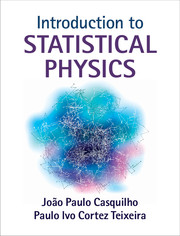Book contents
- Frontmatter
- Dedication
- Contents
- Preface
- Acknowledgements
- 1 Random walks
- 2 Review of thermodynamics
- 3 The postulates of statistical physics. Thermodynamic equilibrium
- 4 Statistical thermodynamics: developments and applications
- 5 The classical ideal gas
- 6 The quantum ideal gas
- 7 Magnetism
- 8 The Ising model
- 9 Liquid crystals
- 10 Phase transitions and critical phenomena
- 11 Irreversible processes
- Appendix A Values of some fundamental physical constants
- Appendix B Some useful unit conversions
- Index
- References
7 - Magnetism
Published online by Cambridge University Press: 18 December 2014
- Frontmatter
- Dedication
- Contents
- Preface
- Acknowledgements
- 1 Random walks
- 2 Review of thermodynamics
- 3 The postulates of statistical physics. Thermodynamic equilibrium
- 4 Statistical thermodynamics: developments and applications
- 5 The classical ideal gas
- 6 The quantum ideal gas
- 7 Magnetism
- 8 The Ising model
- 9 Liquid crystals
- 10 Phase transitions and critical phenomena
- 11 Irreversible processes
- Appendix A Values of some fundamental physical constants
- Appendix B Some useful unit conversions
- Index
- References
Summary
Introduction
In this chapter we extend the study of the magnetic properties of solids beyond the simple, ideal-gas-type paramagnetic models of previous chapters. Our purpose is to describe more complex magnetic phenomena, such as ferromagnetism, antiferromagnetism, and elementary excitations in solids. In addition to its intrinsic interest, magnetism here plays an important role in illustrating how the methods of statistical physics can be applied to systems of interacting particles and to phase transitions, which are of great importance in condensed matter physics.
Electrons in solids generate magnetic fields, since they are moving charges with intrinsic magnetic dipole moments due to their spin. The magnetic fields generated by the nuclear spins are much smaller than those of the electrons, and their contribution to the magnetisation of a solid can be neglected. If the atoms in a solid have permanent magnetic dipole moments, the solid will be paramagnetic or ferromagnetic. More complex behaviours such as antiferromagnetism and ferrimagnetism are also possible (see Figure 7.1). The main contributions to the magnetisation of a solid can come either from the interaction between the electrons and an applied magnetic field, or from interactions between the electrons themselves. If the latter are weak enough to be negligible, the system of magnetic moments can, to a first approximation, be regarded as ideal. This was the subject of our study of paramagnetism in Chapter 3, where we treated a paramagnetic solid as an isolated system, and in Chapter 4, where we treated it as a system in equilibrium with a heat reservoir. Otherwise, when the interactions between electrons are to be taken into account, the collective behaviour of a large number of magnetic moments has to be studied in the more general framework of non-ideal systems. Such is the case with ferromagnetism and antiferromagnetism, for which we shall develop models in this chapter.
A simplified model of a paramagnetic solid was introduced in Chapter 4 that consisted of N identical, ideal spins located at the sites of a lattice and in equilibrium with a heat reservoir, which is the sample itself.
- Type
- Chapter
- Information
- Introduction to Statistical Physics , pp. 188 - 219Publisher: Cambridge University PressPrint publication year: 2014

